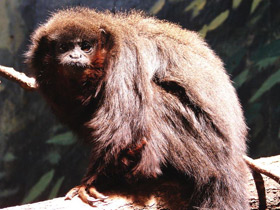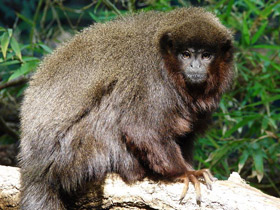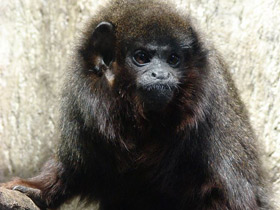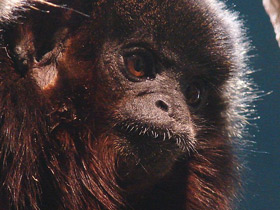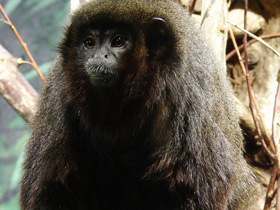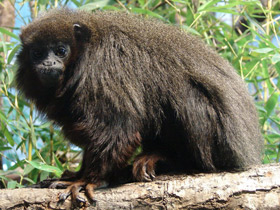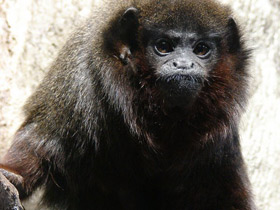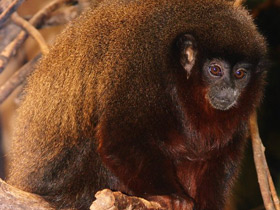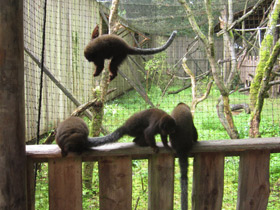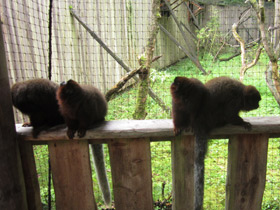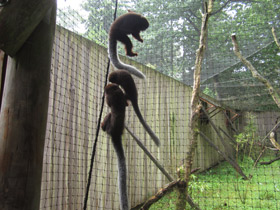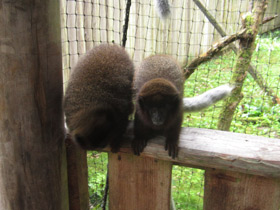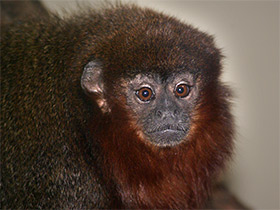The coppery titi monkey (Callicebus cupreus o Plecturocebus cupreus)
The coppery titi monkey (Callicebus cupreus o Plecturocebus cupreus), or red titi monkey, is a species of titi monkey, a type of New World monkey, from South America. They are found in the Amazon of Brazil and Peru, and perhaps northern Bolivia. It was described as Callithrix cupreus in 1823. These monkeys have a lifespan of a little over 20 years. These monkeys eat certain fruits, insects, and plants. They live in monogamous pairs with interesting ways for vocalizing and protecting themselves from predators.
Appearance
Callicebus cupreus is a species of platyrrhine primate of the family Pitheciidae.
Callicebus cupreus is quite common in Peru, Brazil, Ecuador, Colombia, Venezuela and Bolivia. It is named for its colouring: its cheeks, neck, inner limbs, belly and thorax are coppery red, while the back, base of the tail and head are brown, and males and females are similarly coloured.
Callicebus cupreus has strong forelimbs and hind limbs shorter than the forelimbs. Its fur is dense, fluffy, rough to the touch; its face is partially naked; its tail is long, non-gripping, and serves to maintain balance. This primate has 36 teeth, a prominent forward jaw, large protruding incisors, massive fangs and small molars. The body length of Callicebus cupreus is 30-36 cm, the length of the tail varies from 33 to 45 cm, the weight of females is 0.7-1 kg, males 0.8-1.3 kg.
Habitat and nutrition
These primates inhabit primary and secondary forests, with a preference for the latter. They are usually found in humid coastal (flooded) and lowland gallery forests, bamboo groves and swamps.
Callicebus cupreus are omnivorous primates; they feed on soft fruits, seeds, leaves, pollen and other plant parts. Insects, spiders and small vertebrates make up a small part of their diet. Callicebus cupreus spends up to 75% of its feeding time eating fruits and berries (preference is given to the fruits of ficus and milk fruit), and the remaining 25% eating bamboo leaves and stems. However, during lactation, females eat twice as many insects as usual to increase milk production.
Lifestyle and behaviour
Callicebus cupreus are diurnal and arboreal, rarely descending to the ground. These monkeys are good climbers, move on four limbs, and are also agile and long jumpers (even their name suggests this). Most of the time, they roam on horizontal branches 2 to 10 cm in diameter.
These primates live in pairs or small family groups of up to 5 animals, usually consisting of a breeding pair and their offspring. Each group covers an area of 6 to 12 hectares and is protected by males and females.
Callicebus cupreus emit loud cries to warn that territory is occupied, but physical conflict between neighbouring groups is extremely rare. Usually, when the monkeys wake up at dawn, they clean themselves and urinate, and then start the morning song, in which both males and females participate.
Callicebus cupreus has an elaborate vocal communication system consisting of whistles, squeaks, grunts and groans. Morning duets are usually sung near the boundaries of the group's territory and serve to alert neighbouring groups that the territory is occupied. Once the song is finished, the group leaves to feed, followed by a short rest, and two hours before bedtime Callicebus cupreus returns to forage for food. All members of the group feed from the same tree at the same time in the lower level of the forest.
Sometimes more than one primate species may feed in the large fruit trees: Callicebus, marmosets and сallithricidae.
Most of their free time (up to 47%) is spent socialising with each other: grooming (grooming and deworming), playing, sitting and sleeping together, intertwining their tails. Callicebus cupreus usually roosts in tall trees (20-25 m) with dense foliage and undergrowth or thickets of lianas. Callicebus cupreus has a well-developed sense of smell, which plays an important role in interactions. To mark their territories, males rub their thorax against horizontal branches and deposit odorous secretion from sternal glands on them.
Vocalization and communication
Coppery titis are highly vocal animals with a complex set of vocalizations and sounds. Coppery titis will vocalize with grunts, screams, whistles and moans. Their most frequent vocalizations are bellows, pumping, and panting, which are the main components of male-female pair duets. These duets are daily performances which occur during or before sunrise near the edge of their territories. Neighboring pairs respond to each other's duets, establishing territorial boundaries. Duets can last up to five minutes, beginning with moaning and ending with honking. For the duration of the duet, males and females will alternate between bellowing calls and panting responses. Between these sequences, the titis will synchronize in a pumping transition. The amount of time spent between synchronized transitions changes over time. Newly paired couples will spend more time between transitions, while older pairs typically show less variability in the length of each sequence between transitions. It seems that weather also has an effect on duetting; they will spend more time duetting on overcast days rather than clear ones. However, they do not perform duets while it rains. Their vocalizations can be heard up to one kilometer, and come in different frequencies and pitches, making it so that if studied, or with careful listening, you can identify them individually. Adult vocalizations are identifiable through an 83% accuracy and infants with a 48% accuracy with a leave-one-out cross validation method of quantitative research. Therefore, it is easier to identify adult coppery titi monkeys, and harder to identify infants. This is beneficial for territorial boundaries and being able to identify their other pair when vocalizing from farther distances in instances where they cannot use other senses to identify the other. Smelling is a form of communication for the Coppery Titi Monkeys. To identify a monkey from up close, they will smell each other's faces. A way to advance before getting involved in sexual intercourse, a male will smell the female's genitals.
Reproduction
Callicebus cupreus is monogamous. The average calving interval in this species is between 318 and 335 days. The young are born at their best between November and March, and gestation lasts between 5 and 6 months. The female usually gives birth to a single calf weighing about 75g. Within 48 hours of birth, the male takes care of the calf: he carries the calf on his back (up to 85% of the time), cares for it, plays with it and protects it; the mother only has contact with the calf during the nursing period. Lactation lasts up to 4 months. Until 4-6 months of age, the father carries the calf on his back.
Ecological role, predation, and conservation
The ecological role of the coppery titi is an important one for the sake of local biodiversity. Coppery titis scatter the seeds of fruits within their habitats, promoting continued growth. Coppery titis are hunted by birds of prey and feral cats. There have been observations of possible predators that have not been officially confirmed which include ocelots, boas, tayras, an unidentified hawk, gray-headed kites, a squirrel monkey, and a capuchin monkey. Threats from human predation are low, as they do not compose the diets of local hunters, unlike larger neotropical primates. Despite this, they are occasionally hunted as bushmeat and for their tails. Due to their location in a remote, isolated region however, the International Union for Conservation of Nature's Red List of Threatened Species (IUCN) puts the coppery titi in the Least Concern (LC) category of endangerment.

















